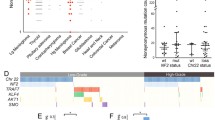Abstract
We investigated factors of the early recurrence and malignant transformation of histologically benign meningiomas using immunohistochemistry for MIB-1 positive indices (PI) and p53 protein expression, a flow cytometric DNA analysis, and the examination of numerical chromosomal aberrations detected by fluorescence in situ hybridization using an α-satellite DNA probe and abcr gene locus-specific probe. Twenty-six meningiomas of 23 patients were classified into two groups: the 3 patients in whom a recurrence was defined within two years after initial surgery and who showed histologically malignant features were classified as the early recurrent group, and the other 20 patients in whom recurrence did not develop during the same period were classified as the nonrecurrent group. DNA aneuploidy was observed in 40% of the nonrecurrent patients and in 67% of the early recurrent patients. Loss of chromosome 22 was the most common numerical aberration, but the aberrations characteristic of early recurrent meningiomas were not detected. The MIB-1 PI values of the early recurrent meningiomas were higher than those of nonrecurrent meningiomas, suggesting that MIB-1 PI is very important for biological and histopathological analyses and prediction of the future recurrence of meningiomas.
Similar content being viewed by others
References
Kleihuse P, Burger PC, Scheithauer BW (1993) The new WHO classification of brain tumors. Brain Pathol 3:255–269
Adegbite AB, Khan MI, Paine KWE (1983) The recurrence of intracranial meningiomas after surgical treatment. J Neurosurg 58:51–56
Mirimanoff RO, Dosoretz DE, Linggood RM (1985) Meningiomas: analysis of recurrence and progression following neurosurgical resection. J Neurosurg 62:18–24
Sasaki K, Murakami T (1992) Clinical application of flow cytometry for DNA analysis of solid tumors. Acta Pathol Jpn 42:1–14
Pinkel D, Sakamoto M, Matumura K (1992) Application of fluorescence in situ hybridization to detection of chromosomal aberrations. Cytom Res 2(1):1–11
Barthel B, Martin NR, Johannes S et al. (1983) Flow cytometry in clinical cancer research. Cancer Res 43:982–997
Douglas EM, William LM (1990) Ploidy, proliferative activity and prognosis. DNA flow cytometry of solid tumors. Cancer 65:1194–1205
Deith AD, Strand MA, DEVere White RW (1989) Deoxyribonucleic acid flow cytometry of benign prostatic disease. J Urol 142:759–762
Hostetter AL, Hrafnkelsson J, Wingren SOW et al. (1988) A comparative study of DNA cytometry methods for benign and malignant thyroid tissue. Am J Clin Pathol 89:760–763
Zankl H, Zang KD (1980) Correlations between clinical and cytogenetical data in 180 human meningiomas. Cancer Genet Cytogenet 1:351–356
Casartelli C, Rogatto SR, Neto JB (1989) Karyotypic evolution of human meningioma. Cancer Genet Cytogenet 40:33–45
Al Saddi A, Latimer F, Madercic M et al. (1987) Cytogenetic studies of human brain tumors and their clinical significance. Cancer Genet Cytogenet 26:127–141
Casalone R, Granata P, Simi P et al. (1987) Recessive cancer genes in meningiomas? An analysis of 31 cases. Cancer Genet Cytogenet 27:145–159
Dumanski JP, Carlbom E, Collins VP et al. (1987) Deletion mapping of a locus on human chromosome 22 involved in the oncogenesis of meningioma. Proc Natl Acad Sci USA 84:9275–9279
Seizinger BR, de la Monte S, Atkins L et al. (1987) Molecular genetic approach to human meningioma: loss of genes on chromosome 22. Proc Natl Acad Sci USA 84:5419–5423
Miyagami M, Kanou T, Nakamura S (1996) p53 protein expression and proliferative potential in non-recurrent and recurrent meningiomas. No-To-Shinkei 48:719–725
Cobb MA, Husain M, Andersen BJ et al. (1996) Significance of proliferating cell nuclear antigen in predicting recurrence of intracranial meningioma. J Neurosurg 84:85–90
Madsen C, Schroder HD (1997) Ki-67 immunoreactivity in meningiomas: determination of the proliferative potential of meningiomas using the monoclonal antibody Ki-67. Clin Neuropathol 16:137–142
Nakagawa K, Sugawara N, Ueda S et al. (1997) Measurement of cell kinetic parameters in meningiomas. Neurol Med Chir Tokyo 37:12–17
Yasue M, Akasaki Y, Numoto TR et al. (1996) MIB-1 immunostaining and DNA flow cytometry in meningiomas. Noshuyo Byouri 13:17–20
Moller ML, Braendstrup O (1997) No Prediction of recurrence of meningiomas by PCNA and Ki-67 immunohistochemistry. J Neurooncol 34:241–246
Author information
Authors and Affiliations
Rights and permissions
About this article
Cite this article
Arai, H., Beppu, T., Wada, T. et al. Pathological analyses of early recurrence and malignant transformation in meningiomas. Brain Tumor Pathol 15, 37–40 (1998). https://doi.org/10.1007/BF02482099
Received:
Accepted:
Issue Date:
DOI: https://doi.org/10.1007/BF02482099




